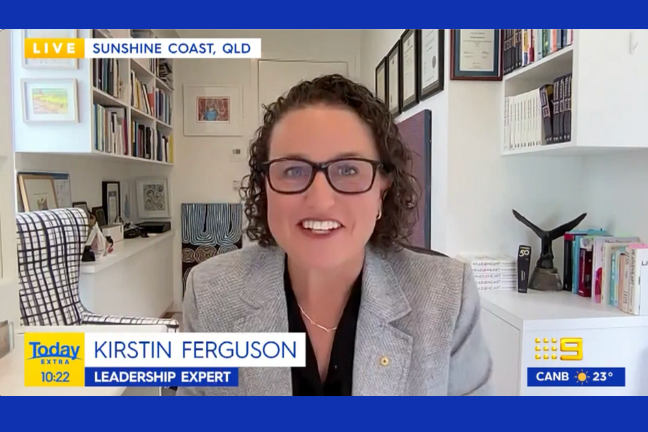
Complete the Head & Heart Leader Scale™ and receive a free, personalised report here.
Complete the Head & Heart Leader Scale™ and receive a free, personalised report here.
11 October 2023
Anitha Moosath
Effective leadership demands getting past stereotypes and drawing upon both intellectual and emotional virtues at work, argues award-winning leadership expert Kirstin Ferguson in her book Head & Heart: The Art of Modern Leadership
Kirstin Ferguson is an award-winning leadership expert, columnist, and keynote speaker. She is the former Acting Chair and Deputy Chair of the Australian Broadcasting Corporation and the best-selling author of Head & Heart: The Art of Modern Leadership. In this interview with Forbes India, she talks about the art of modern leadership. Edited excerpts:
Q. What is your definition of ‘leadership’?
Leadership is simply a series of moments, and every moment offers us the opportunity to leave a positive (or negative) impact on others. Modern leaders understand how fleeting those moments can be and seize each one to ensure they leave a positive legacy, and not rough waters, in their wake.
When we think back to the times when leaders like our parents, bosses, or others who impact our lives have made us feel good—perhaps helped us to say yes to an opportunity we might not have realised we were ready for—it always comes down to a particularly pivotal moment. The same applies to leaders who belittle us, question our expertise, reject diverse points of view.
Regardless of who we are, or how we live, work, and play, every moment is an opportunity for our words and actions to have an impact on those around us.
Q. Could you explain the concept of ‘everyday leadership’, the kind that gets past formal titles and positions?
Too often we think of leaders as someone more powerful than ourselves. This is not surprising—it has been ingrained in us through centuries of thinking of leaders as those men (and generally it was always men) with authority and power. Explorers, kings, generals on the battlefield, titans of industry. These are the kinds of formal leaders we have heard most about.
The problem is thinking about leadership as only involving formal leaders, often we, or those we lead, may not think of themselves as leaders either.
Now of course, I am not suggesting everyone is the CEO—that would lead to chaos—but it is important to remind ourselves that beyond our formal titles, we are leaders outside of work. And within our teams, even those with no formal authority can be encouraged to remember that they too, are leaders in their roles, in their families and in their communities.
Q. Who’s a truly ‘modern’ leader? What is it about our times that demands a change in approach?
Modern leaders draw on qualities we all have, often in abundance, and which we can develop even further as we become conscious of the impact we have on others. Leadership is not a scarcity competition; everyone wins when we all lead well.
A leader is anyone who can influence and impact others through their words, actions, and behaviours. A modern leader understands the most effective way to lead is by using their head and heart. The ‘art’ of modern leadership is knowing which attributes of your head and heart are needed, and when.
Q. You refer to the leadership styles of [former New Zealand PM Jacinda] Ardern and [Ukrainian President Volodymyr] Zelensky. How do they combine head and heart?
Ardern and Zelensky have stood out on the world stage precisely because they are such different leaders than we are used to. What stands them apart is their ability to seamlessly integrate their personal qualities and authenticity with the authority invested to them through their formal roles.
Ardern and Zelensky stand apart from polished career politicians and corporate leaders who curate an image of themselves for public consumption, different to that they have in their private lives. Modern leaders like Ardern and Zelensky realise integrating how they show up as leaders in public with the leaders they are in private is what makes them effective.
Q. What are the crucial head and heart attributes needed to get into that mould?
The art of being a modern leader is knowing what balance of head and heart leadership attributes are needed, and when. In any given situation, context or conversation, you will need to draw on skills from both the head and heart to be the most effective leader you can be.
There is no one way of leading well. Everyone will do it differently. The more attributes of the head and heart you can draw upon, the more effective you will be in the widest range of situations you might find yourself leading in.
My research identified eight head and heart leadership attributes (four head-based and four heart-based):
Anyone can measure their own head and heart leadership by taking the Head & Heart Leader Scale I developed with Queensland University of Technology. Simply visit www.headheartleader.com
Q. How can empathy play out while working with remote teams?
Empathy is always a crucial leadership attribute but especially when you are leading remote teams. While empathy involves being able to put yourself in the shoes of others, for modern leaders it also means understanding not everyone has the same lived experience you do, so you need to deliberately seek out diverse points of view to make the best decisions you can.
In remote teams, this translates to needing to understand those you lead you don’t see every day and the circumstances they might be dealing with of which you may be completely unaware. It means not just relying on those people you see every day to make decisions but also making time to seek out the people you don’t see to make sure all voices are heard.
Q. What are the virtues of a growth mindset?
Having a growth mindset speaks to our underlying beliefs about failure and success. If we adopt a growth mindset, as opposed to a fixed mindset, we seek to understand why we might have failed at something and can respond quickly.
At Microsoft, CEO Satya Nadella has drawn on the work of Stanford psychologist Carol Dweck and embedded a growth mindset across the organisation through the Model-Coach-Care framework. By doing so, Nadella has signalled to leaders across Microsoft the importance of head and heart leadership attributes like self-awareness, humility, and curiosity.
Model-Coach-Care represents how Microsoft views the role of leaders. Essentially, leaders deliver success through empowerment and accountability via role modelling what it means to have a growth mindset, coaching others to learn from mistakes, and caring about team members’ capabilities and aspirations.
Q.‘Learning to read the room’—how important is this for a leader?
In my research, leading with perspective (or being able to ‘read a room’) was the attribute that correlated most highly with being a modern leader. This means we are not only highly skilled at reading what is going on in the room we are in (whether that is a literal room, or your organisation, or your industry) but you notice who is missing from the room too. Not only that but leaders who are skilled at reading a room also notice what is going on outside the room as well.
Q. In most organisations, leadership development programmes are intrinsically flawed. What’s the best way to create a robust leadership pipeline?
Research shows that most leadership development is offered far too late in someone’s career. On average, formal leadership training is offered thirteen years after someone starts in a formal leadership role.
To create robust leadership pipelines of men and women in our organisations we need to start ensuring even our most junior employees understand the leadership role they can play. This includes developing a pipeline of individuals in an organisation to understand what it means to be a leader, the kind of leadership qualities which need to be role modelled, and promotion and remuneration systems focussed on the attributes of a modern leader.




